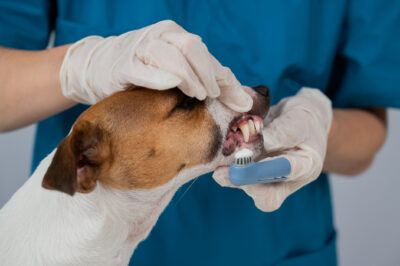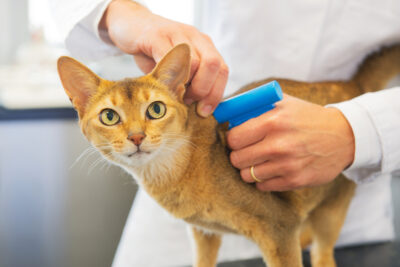10 Spring Hazards for Pets: What to Watch Out for This Season

All featured products are chosen at the discretion of the GreatPetCare editorial team and do not reflect a direct endorsement by the author or reviewer.
Spring brings beautiful weather, but with it also comes several potential hazards for dogs and cats. From toxic plants to fleas and ticks, it’s important to be aware of the dangers your pet could get into.
Let’s explore some of the top spring hazards for pets — and how you can keep your furry family members safe.
10 Spring Hazards for Pets
Standing/Communal Water
As temperatures rise, our pets will be drinking more to stay cool. While streams and puddles may seem like convenient water sources, they can carry harmful bacteria, parasites, and even toxins. “Drinking from these sources can expose your pet to diseases like leptospirosis and giardia, which can also be spread to humans,” says Dr. Liza Cahn, a veterinary consultant with Embrace Pet Insurance.
And while water bowls at your local outdoor patios may be tempting, Dr. Cahn explains they can also be an easy source of passing diseases between dogs, such as the dog flu and kennel cough. To keep your pet safe, it’s best to carry fresh water and a travel water bowl with you during outdoor activities.
External Parasites

With warmer weather comes an influx of pesky parasites like fleas, ticks, and mosquitoes, all of which can spread disease. “Fleas and ticks surge in the spring, so it’s crucial that your pet is up-to-date on their flea, tick, and heartworm prevention,” explains Dr. Whitney Miller, chief veterinarian at Petco.
Pet parents should use veterinary-recommended parasite control such as Midamox Topical Solution on their pets year-round, not just in the spring. But, it helps to avoid the spots where these pests thrive during the spring, like tall grass and woodsy areas.


Here is a closer look at each of these pests:
Fleas
Fleas are a common nuisance, but they can cause more issues than itching. “Fleas can lead to blood loss, anemia, and allergic reactions,” Dr. Cahn says. If your pet is allergic to flea saliva, even a single bite can cause severe, widespread skin irritation. Fleas can also transmit tapeworms if eaten — which is common when your pet is biting their skin to relieve the itching they cause.
To prevent infestations, use flea preventatives recommended by your veterinarian. Remember to only use feline-specific flea meds on your cat — many canine flea control products are toxic to cats.
Ticks
Ticks can transmit some serious diseases, such as Lyme disease and anaplasmosis. Dr. Cahn advises checking your pet for ticks after outdoor activities, especially in wooded or grassy areas. If you find a tick, remove it promptly using fine-tipped tweezers, not your fingers. Early removal is key to preventing the spread of disease, and staying on top of tick control can help ensure ticks die before they get a chance to hurt your pet.
Mosquitoes
Mosquitoes may seem like a minor annoyance, but they’re a major concern thanks to their role in spreading heartworm disease. “Heartworm larvae are transmitted when an infected mosquito bites your pet,” Dr. Cahn explains. The larvae mature in the heart and lungs, causing serious health issues. Keeping your pet on preventive heartworm medication is the best way to protect them from this potentially fatal disease.
Intestinal Parasites
More time outside means more exposure to intestinal parasites, such as hookworms, roundworms, and whipworms. These parasites are often spread through contaminated soil or feces from other animals. Symptoms may not always be obvious, but some signs that your pet has intestinal parasites can include diarrhea, vomiting, and weight loss.
“Use a prescription preventative from your vet year-round and have your pet’s fecal sample checked annually to reduce the risk,” Dr. Cahn says. And always remember to clean up after your pet to prevent spreading worms to others!
Hot Cars and Heat Stroke
With temperatures rising, heat stroke starts to become a real concern for pets during the spring months, especially when left in a parked car. Dogs and cats don’t regulate their body temperature as efficiently as humans, making them vulnerable to overheating. “Never leave your pet unattended in a car, as heat stroke can occur within minutes,” Dr. Cahn warns.
Signs of heat stroke include excessive panting, lethargy, collapse, and difficulty breathing. If you think your pet is suffering from heat stroke, get them to an emergency vet ASAP.
Toxic Plants

Springtime means flowers and plants are in full bloom, but some of these can be toxic to pets. Common flowers like lilies, daffodils, and tulips can lead to serious health problems if accidentally eaten. “Symptoms of plant poisoning can include vomiting, diarrhea, drooling, lethargy, tremors, difficulty breathing, and even kidney failure and seizures,” Dr. Cahn says. Some symptoms occur right away, while others may take days to develop.
Here is a list of common plants and flowers that are toxic that pet parents may stumble upon in the spring:
- Aloe
- Apple trees
- Azaleas
- Birds of Paradise
- Boxwoods
- Calla Lily
- Lily of the Valley
- Holly
- Oleanders
- Wisteria
- Amaryllis
- Daffodil
- Eucalyptus
- Mums
- Sago Palm
- Tulip and Hyacinth bulbs
- Poinsettia
Dr. Miller advises pet parents to keep plants out of reach in your home and be cautious when walking in areas where these plants are common. If you think your pet may have eaten something toxic, use the Pet Poison Hotline for advice or get them to your vet right away.
Seasonal Allergies
Just like humans, pets can suffer from the onslaught of seasonal allergies during warmer months. Pollen, grass, and other environmental irritants are more prevalent in the spring, leading to symptoms such as:
- Excessive biting or scratching at skin
- Ear infections
- Skin redness
- Hair loss
- Sneezing
- Watery eyes
- Pawing at eyes or ears
“Environmental allergies, or atopy, can cause a lot of discomfort for pets, so it’s important to work with your veterinarian for proper diagnosis and treatment,” Dr. Cahn says. They can help identify what allergens are causing the most problems and recommend strategies to help lessen the symptoms through medications, special diets, or immunotherapy.
Bee/Wasp Stings
Bee stings typically cause only slight discomfort, like mild swelling and pain at the sting site, and will subside on their own. Pet parents can apply a cold compress to the sting site to reduce inflammation, though it’s not always necessary. In some cases, your vet might suggest giving antihistamines (such as Benadryl) to help, but this should only be done under veterinary guidance.
While most stings aren’t something to worry about, some pets can experience severe allergic reactions, especially if stung multiple times. “If you notice signs of a more serious reaction, like facial swelling, difficulty breathing, vomiting, or hives, get your pet to the vet immediately,” advises Dr. Miller.
Open Windows and Doors

With warmer weather comes the temptation to open windows and doors for fresh air. However, this can lead to accidents if your pet escapes or falls. Cats, in particular, are at risk of falling from windows or balconies. While we may think cats can land on their feet, a fall from this height can lead to an array of injuries, such as broken limbs, chest trauma, head injuries, and shock — a condition known as high-rise syndrome.
“Make sure that window screens are secure and your pet doesn’t have access to open windows or balconies,” Dr. Cahn advises. She suggests microchipping your pet, too, in case they do get out and wander off.
Toxic Products
Spring cleaning often involves chemicals like bleach and essential oils or fertilizers and pesticides, many of which can be toxic to pets. These products can cause skin irritation or chemical burns if your pet comes into contact with them, or serious health problems if ingested.
“Eating a few blades of grass with fertilizer on them is unlikely to result in poisoning, but if a pet gets into a direct source of fertilizer, they could experience serious effects like vomiting, diarrhea, and seizures,” Dr. Miller warns.
To keep your pet safe, use pet-friendly cleaning products and store harmful substances out of their reach. If you suspect poisoning, contact your vet or a pet poison hotline immediately.
Easter and Valentine’s Day Candy
Spring brings several holidays that are celebrated with candy and sweets, which often contain ingredients that are harmful to our pets. Harmful ingredients may include:
- Xylitol: This sweetener is commonly used in sugar-free products, such as candy, gum, diet foods, baked goods and toothpaste. It can cause a severe drop in blood sugar or even liver failure in dogs (though cats don’t seem quite as affected). Symptoms can start minutes after eating xylitol, so time is of the essence if your pup accidentally eats any.
- Nuts: Due to their size, many nuts (like pistachios) pose a choking hazard to pets. Their teeth aren’t made for crunching on nuts like ours are, so pets often accidentally swallow nuts whole. Other nuts can be high in sodium and lead to pancreatitis in cats or are poisonous, like macadamia nuts, and should be completely off-limits to pets.
- Chocolate: Chocolate is toxic to dogs and cats due to its high levels of caffeine and theobromine. The darker the chocolate, the higher the concentration, which makes dark (including bakers) chocolate the most dangerous. Eating chocolate can cause vomiting and diarrhea in pets, or more serious symptoms like abnormal heartbeat, muscle tremors, and seizures.
By taking proper precautions and following these springtime safety tips for pets, you can help keep your dog or cat safe and healthy this season.









